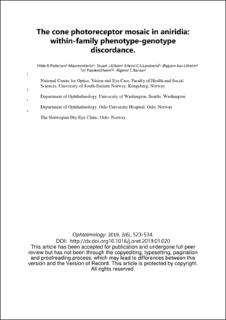| dc.contributor.author | Pedersen, Hilde Røgeberg | |
| dc.contributor.author | Neitz, Maureen | |
| dc.contributor.author | Gilson, Stuart | |
| dc.contributor.author | Landsend, Erlend Christoffer Sommer | |
| dc.contributor.author | Utheim, Øygunn Aass | |
| dc.contributor.author | Utheim, Tor Paaske | |
| dc.contributor.author | Baraas, Rigmor C. | |
| dc.date.accessioned | 2020-03-19T13:17:17Z | |
| dc.date.available | 2020-03-19T13:17:17Z | |
| dc.date.created | 2019-11-07T15:36:10Z | |
| dc.date.issued | 2019 | |
| dc.identifier.citation | Ophthalmology Retina. 2019, 3 (6), 523-534. | en_US |
| dc.identifier.issn | 2468-7219 | |
| dc.identifier.uri | https://hdl.handle.net/11250/2647591 | |
| dc.description.abstract | Purpose Investigate in vivo cone photoreceptor structure in familial aniridia caused by deletion in the PAX6 gene to elucidate the complexity of between-individual variation in retinal phenotype. Design Descriptive case-control study. Participants Eight persons with congenital aniridia (40–66 yrs) from 1 family and 33 normal control participants (14–69 yrs), including 7 unaffected family members (14–53 yrs). Methods DNA was isolated from saliva samples and used in polymerase chain reaction analysis to amplify and sequence exons and intron or exon junctions of the PAX6 gene. High-resolution retinal images were acquired with OCT and adaptive optics scanning light ophthalmoscopy. Cone density (CD; in cones per square millimeter) and mosaic regularity were estimated along nasal–temporal meridians within the central 0° to 5° eccentricity. Horizontal spectral-domain OCT line scans were segmented to analyze the severity of foveal hypoplasia (FH) and to measure retinal layer thicknesses.Main Outcomes and Measures Within-family variability in macular retinal layer thicknesses, cone photoreceptor density, and mosaic regularity in aniridia compared with normal control participants. Results DNA sequencing revealed a known PAX6 mutation (IV2-2delA). Those with aniridia showed variable iris phenotype ranging from almost normal appearance to no iris. Four participants with aniridia demonstrated FH grade 2, 2 demonstrated grade 3 FH, and 1 demonstrated grade 4 FH. Visual acuity ranged from 0.20 to 0.86 logarithm of the minimum angle of resolution. Adaptive optics scanning light ophthalmoscopy images were acquired from 5 family members with aniridia. Foveal CD varied between 19 899 and 55 128 cones/mm2 with overlap between the foveal hypoplasia grades. Cone density was 3 standard deviations (SDs) or more less than the normal mean within 0.5°, 2 SDs less than the normal mean at 0.5° to 4°, and more than 1 SD less than the normal mean at 5° retinal eccentricity. Conclusions The results showed considerable variability in foveal development within a family carrying the same PAX6 mutation. This, together with the structural and functional variability within each grade of foveal hypoplasia, underlines the importance of advancing knowledge about retinal cellular phenotype in aniridia. | en_US |
| dc.language.iso | eng | en_US |
| dc.rights | Attribution-NonCommercial-NoDerivatives 4.0 Internasjonal | * |
| dc.rights.uri | http://creativecommons.org/licenses/by-nc-nd/4.0/deed.no | * |
| dc.title | The cone photoreceptor mosaic in aniridia: within-family phenotype-genotype discordance | en_US |
| dc.type | Peer reviewed | en_US |
| dc.type | Journal article | en_US |
| dc.description.version | acceptedVersion | en_US |
| dc.source.pagenumber | 523-534 | en_US |
| dc.source.volume | 3 | en_US |
| dc.source.journal | Ophthalmology Retina | en_US |
| dc.source.issue | 6 | en_US |
| dc.identifier.doi | 10.1016/j.oret.2019.01.020 | |
| dc.identifier.cristin | 1745038 | |
| cristin.ispublished | true | |
| cristin.fulltext | postprint | |
| cristin.qualitycode | 1 | |

